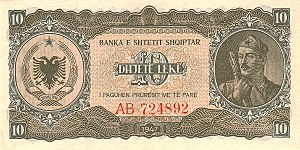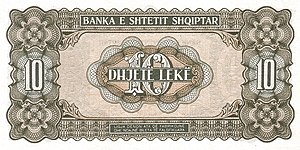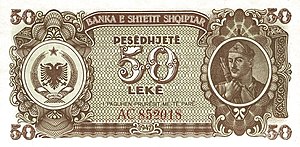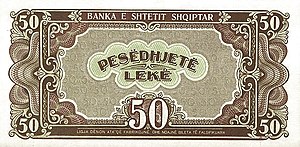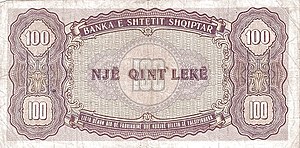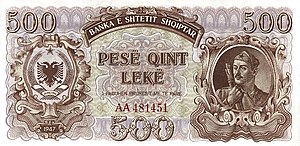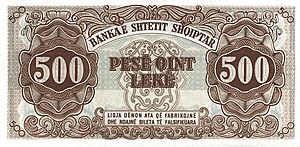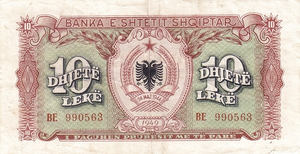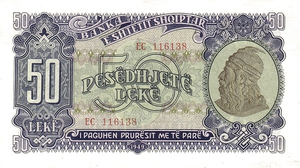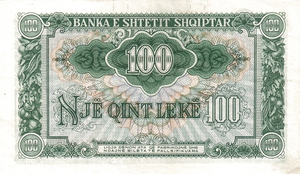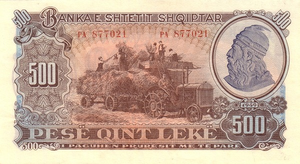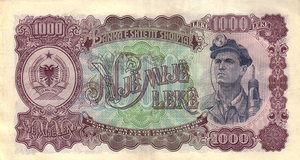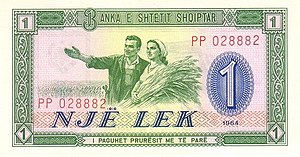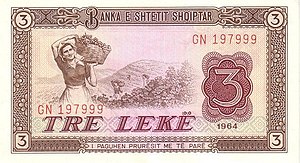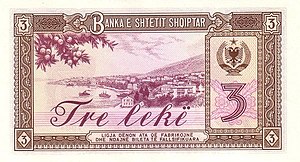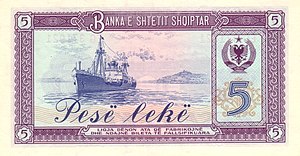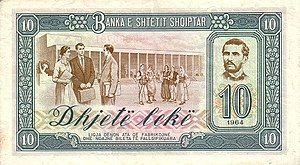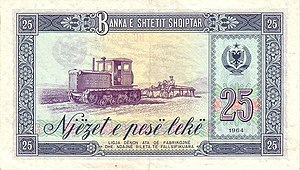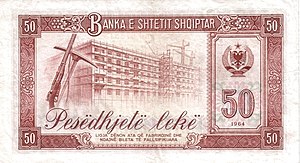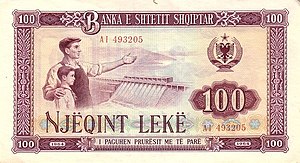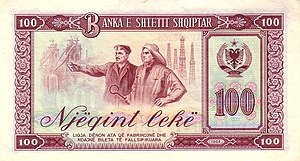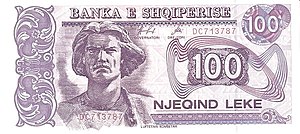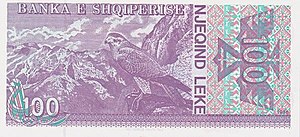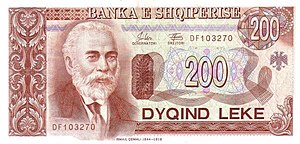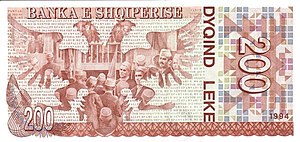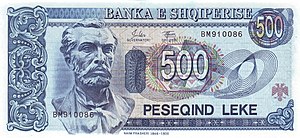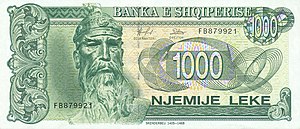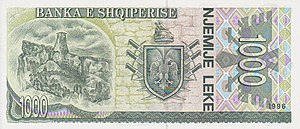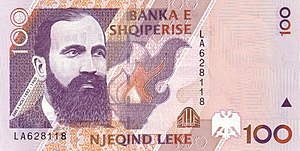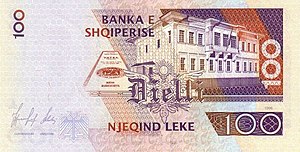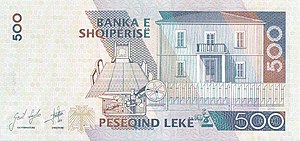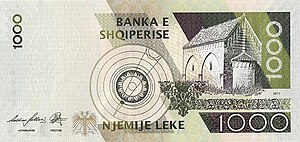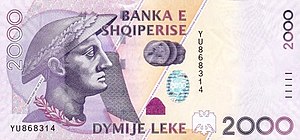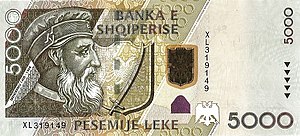|
Albanian lek
The lek (Albanian: leku shqiptar; indefinite singular lek, definite plural lekët, indefinite plural lekë; sign: L;[1] code: ALL) is the currency of Albania. Historically, it was subdivided into 100 qintars (Albanian: qindarka; singular qindarkë). History The lek was introduced as the first Albanian currency in February 1926.[2] Before then, Albania was a country without a currency, adhering to a gold standard for the fixation of commercial values. Before the First World War, the Ottoman Turkish piastre was in full circulation. During the occupation of Albania by Austria-Hungary, paper notes of the Austro-Hungarian krone were imposed on the population. Although transactions using krone notes were limited to exchanges between Albanians and the occupiers, the majority of the population used gold and silver piastre or, gave up on money altogether and bartered instead.[3] In 1923 Italian paper circulated at Shkodër, Durrës, Vlorë, and Gjirokastër, and the Greek drachma at Korçë, the values of which varied according to locality and the prevailing rates of exchange as compared with gold.[4] Gold standardFrom 1926–1939, the Albanian leke adhered to the gold standard de jure with leke banknotes being convertible to gold. The leke's conversion to gold was guaranteed and the issue of gold francs was limited to three million units.[5] Due to the gold standard, up until 1939, the leke did not experience significant inflation and the currency in circulation remained relatively constant.[6] Following the Italian invasion of Albania, the entire gold reserves of Albania, totaling 300,000 gold francs, were confiscated and sent to the Reichsbank in Berlin. This action, coupled with the introduction of the Italian lira in Albania, led to significant inflation and the devaluation of the leke.[7] EtymologyThe naming of this currency as "Lek" has two stories, one is that it is named after Alexander the Great,[8] whose name is often shortened to Leka in Albanian.[9] where Alexander's portrait appeared on the obverse of the 1 lek coin, while the reverse showed him on his horse. Meanwhile, the other is that this currency was named after Lekë Dukagjini,[10] which is considered the official reason based on parliamentary discussions in the Parliament of Albania in 1922.[11] The word qindarkë comes from the Albanian qind, meaning one hundred, or from Arabic qintār ("hundredweight"). The word is thus comparable to centime, cent, Latin centenarius, etc. FrangaBetween 1926 and 1939, the main unit of Albanian currency was the franga ari (English: gold franc) (Fr.A.), worth 5 Lek and divided into 100 qindar ar (gold cent),[12] used in international transactions.[13] This unit was similar in concept to the Belga, a unit worth five Belgian francs. CoinsFirst lekIn 1926, bronze coins were introduced in denominations of 5 and 10 qintars, together with nickel 1⁄4 Lek, 1⁄2 Lek and 1 Lek, and silver Fr.A. 1, Fr.A. 2 and Fr.A. 5 . The obverse of the franc coins depicts King Zog. In 1935, bronze 1 and 2 gold cents were issued, equal in value to the 5 and 10 qintars respectively. This coin series depicted distinct neoclassical motifs, said to have been influenced by the Italian king Victor Emmanuel III who was known to have been a coin collector. These coins depict the mint marks "R", "V" or "L", indicating Rome, Vienna or London. Under the direction of Benito Mussolini, Italy invaded and occupied Albania and issued a new series of coins in 1939 in denominations of Lek 0.20, Lek 0.50, 1 Lek and 2 Lek in stainless steel, and silver 5 Lek, and 10 Lek. Aluminium-bronze Lek 0.05 and Lek 0.10 were introduced in 1940. A fixed exchange with the Italian lira was established at 5:6.25 (1 Lek = Lit.1.25, or Fr.A.1 = Lit.6.25). These coins were issued until 1941 and bear the portrait of Italian King Victor Emmanuel III on the obverse and the Albanian eagle with fasces on the reverse. In 1947, shortly after the Communist Party took power, older coins were withdrawn from circulation and a new coinage was introduced, consisting of zinc 1⁄2 Lek, 1 Lek, 2 Lek and 5 Lek. These all depicted the socialist national crest. This coinage was again minted in 1957 and used until the currency reform of 1965. Second lekIn 1965, a confiscatory monetary form was carried out at a rate of 10:1. Aluminium coins (dated 1964) were introduced in denominations of 5, 10, 20 and 50 qintars and 1 Lek. All coins show the socialist state emblem. In 1969, a second series of aluminium 5, 10, 20, 50 qintars and 1 Lek coins was released commemorating the 1944 liberation from fascism. The three smallest denominations remained similar in design to the 1964 series but depicted "1944-1969" on the obverse. The 50 qintar and lek coins showed patriotic and military images. In 1988, a third redesign of aluminium 5, 10, 20, 50 qintars and 1 Lek coins was released. The 50 qindarka and 1 Lek coins were problematically identical in size, weight, and appearance, so aluminium-bronze 1 Lek coins with the inscription "Republika Popullore Socialiste e Shqipërisë" were released later that year for better identification. In 1989, a cupro-nickel 2 Lek coin was introduced. All three of these coin series remained in circulation during and shortly after the 1991 revolution. On 1 January 1992, those coins lost their legal tender status, effectively making qintars obsolete. Foreign exchange certificatesSimilar to many other socialist countries, Albania issued foreign exchange certificates, which only circulated in specially designated shops, and their exchange into regular lek banknotes was prohibited. Third lekIn 1995 and 1996, new coins were introduced in denominations of 1 Lek, 5 Lekë, 10 Lekë, 20 Lekë and 50 Lekë, with a bimetallic 100 Lekë added in 2000.These coins use the letter e instead of the correct ë, but banknotes are spelt correctly.
Commemorative coinsIn 2001, 100 Lekë and 200 Lekë were issued under the theme of Albania's integration into the EU and 50, 100, and 200 lekë under the 500th anniversary of the Statue of David. In 2002, 50 Lekë and 100 Lek were issued for the 90th Anniversary of the Independence of Albania and 20 Lek under the Albanian Antiquity theme. In 2003, 50 lekë was issued in memory of the 100th anniversary of the death of Jeronim De Rada. In 2004, 50 Lekë was issued under the Albanian Antiquity theme depicting traditional costumes of Albania and the ancient Dea. In 2005, 50 Lekë were issued for the 85th anniversary of the proclamation of Tirana as capital and the theme of traditional costumes of Albania. BanknotesFirst lekIn 1926, the National Bank of Albania (Banka Kombëtare e Shqipnis) introduced notes in denominations of Fr.A. 1, Fr.A. 5, Fr.A. 20 and Fr.A. 100. In 1939, notes were issued in denominations of Fr.A. 5 and Fr.A. 20. These were followed in 1944 with notes for 2 Lek, 5 Lek, 10 Lek, and Fr.A. 100. In 1945, the People's Bank of Albania (Banka e Shtetit Shqiptar) issued overprints on National Bank notes for 10 Lek, Fr.A. 20 and Fr.A. 100. Regular notes were also issued in 1945 in denominations of 1, Fr.A. 5, Fr.A. 20, Fr.A. 100 and Fr.A. 500. In 1947, the franga-ari was discontinued and the lek was adopted as the main currency unit, with notes issued for 10 Lek, 50 Lek, 100 Lek, 500 Lek and 1000 Lek.
Second lekIn 1965, notes (dated 1964) were introduced by the Banka e Shtetit Shqiptar in denominations of 1 Lek, 3 Lek, 5 Lek, 10 Lek, 25 Lek, 50 Lek and 100 Lek. A second series of notes was issued in 1976 when the country changed its name to the People's Socialist Republic.
1992 seriesDue to the shortage of cash in circulation, in 1992, banknotes of 10 and 50 foreign currency leks (Lek Valutë ) were issued, while their value was increased 50 times: 10 foreign currency leks = 500 leks, 50 foreign currency leks = 2500 leks . The banknotes were in circulation for only one year and were soon replaced by banknotes of the 1992 model. A banknote of 1 currency lek was printed, but not put into circulation.[17]
1997 seriesOn 11 July 1997, a new series of banknotes dated 1996-97 was introduced.[18] Notes dated 1996 were printed by De La Rue in the United Kingdom.[citation needed] The 2000 lek note was introduced in 2008.
Since 2011 the 100 lek banknote has been removed out of circulation. 2019–2022 seriesIn 2019, the Bank of Albania unveiled a new series of banknotes, featuring the same themes as seen on the 1997 series, but with improved security features and a change in material for the 200 Lek banknote; now being issued as a polymer banknote. This series has also introduced a new denomination, the 10,000 Lek, its highest denominated banknote issued for general circulation. The first two denominations issued for this series, the 200 and 5,000 lekë banknote were issued for circulation on 30 September 2019, with the 1,000 Lek and 10,000 Lek banknotes being released on 30 June 2021, and the 2,000 Lek and 500 Lek banknotes being released on 17 January 2022.
Exchange rates
See alsoReferences
Wikimedia Commons has media related to Money of Albania. External links
|
||||||||||||||||||||||||||||||||||||||||||||||||||||||||||||||||||||||||||||||||||||||||||||||||||||||||||||||||||||||||||||||||||||||||||||||||||||||||||||||||||||||||||||||||||||||||||||||||||||||||||||||||||||||||||||||||||||||||||||||||||||||||||||||||||||||||||||||||||||||||||||||||||||||||||||||||||||||||||||||||||||||||||||||||||||||||||||||||||||||||||||||||||||||||||||||||||||||||||||||||||||||||||||||||||||||||||||||||||||||||||||||||||||||||||||||||||||||||||||||||||||||||||||||||||||||||||||||||||||||||||||||||||||














